|
 Clavaria subacuta Clavaria subacuta
BiostatusOccurrence uncertain
Images (click to enlarge)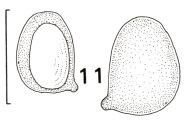
Caption: Fig 11. Clavaria cf. subacuta, spores, TENN no. 55773. Scale bar=5µm. | 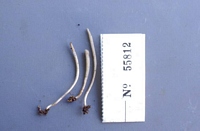
Caption: Microfiche 1-1. Clavaria cf. subacuta. TENN no. 43585. | 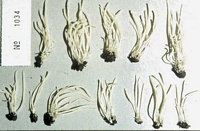
Caption: Microfiche 1-2. Clavaria cf. subacuta. Horak no. 1034. | 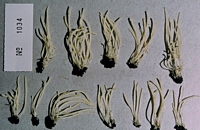
Caption: 1034, id. R. Petersen, label 50x10mm, c.f., NZ, NI, Auckland, Waitakere R., Huia, Karamatura Stream, on soil in
broadleaf-conifer forest, 01.07.1981, leg. EH
Owner: E. Horak | 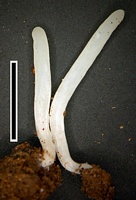
Caption: scale=5mm
Owner: J.A. Cooper | 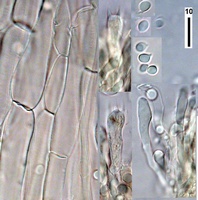
Caption: left: trama. Basidia & spores.
Owner: J.A. Cooper |
Article: Petersen, R.H. (1988). The clavarioid fungi of New Zealand. New Zealand Department of Scientific and Industrial Research, Bulletin 236: 170 pp. Wellington:.
Description: Fruit bodies up to 35 x 2.5 mm, simple clubs, densely cespitose in groups of up to 8
individuals, not fasciculate, arising from very small white mycelial pads. Stipe up to 2 mm
thick, hardly distinguishable from club, white to cream ("light pinkish cinnamon"), glabrous,
not brittle. Club appearing waxy, white to ivory ("cream buff"), tapering somewhat upward,
not brittle; apex narrowly rounded.
Odour and taste negligible.
Tramal hyphae of club hyaline, unclamped, parallel, thin-walled, of two types: 4-15 µm
diam., of long cells, unbranched; and 1.5-3 µm diam., meandering, commonly branched,
and anastomosed. Subhymenium rudimentary. Hymenium thickening; basidia 35-45 x 7-8
µm, clavate, simple-septate, not refringent, empty but persistent after spore discharge;
sterigmata 4, slender, erect.
Spores 4.3-5.0x3.2-3.6 µm (E = 1.20-1.44; Em = 1.31; Lm = 4.56 µm), subglobose to ovate or
broadly ellipsoid, smooth, thin-walled; contents uniguttulate when mature and fresh; hilar
appendix prominent, papillate.
Notes: This was collected under the name Clavaria vermicularis, for fruit bodies appear similar to
juveniles of that species. On closer examination, however, fruit bodies were noted not to be
truly fasciculate (i.e., arising from a multiple primordium below the substrate surface), but
densely cespitose. Moreover, spores are too small for C. vermicularis.
I have not examined the type specimen of Clavaria subacuta, so I use that epithet tentatively,
lto & Imai (1937) described its fruit bodies as fasciculate, but my trouble with that term leads
me to a broad interpretation of their use. Corner (1950; p.220), in his .key to Clavaria taxa,
added the character "basidia without clamps," but I do not know the source of that phrase,
which did not originate in the species circumscription.
Of course, I am led to this epithet by the presence of white fruit bodies, simple clubs, and
small spores. In my material, spores are very scarce and easily overlooked, and very few
have remained uniguttulate through drying.
|